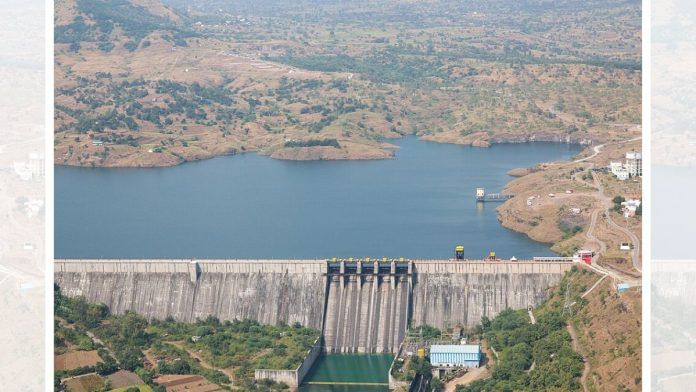Mumbai: The state government is finalising its policy to monetise land near dams in Maharashtra, and the water resources department will float the bid document sometime in early October, ThePrint has learnt.
After several meetings with the chief minister, Water Resources Minister Radhakrishna Vikhe Patil now appears ready to implement a government resolution that opens up waterfront land near 20 dams across the state.
Once released, the standard bid document will bring into force a public-private partnership model. Under it, any private player can get land on a lease signed for 49 years, explained the sources in the department.
The department originally floated the GR in June 2019, when the BJP and undivided Shiv Sena were a part of the ruling alliance. “But then, the code of conduct kicked in, and post-elections, MVA (Maha Vikas Aghadi) came to power. The proposal went into cold storage,” a person close to the development told ThePrint.
“The government changed in 2022, but it (GR) did not progress under Eknath Shinde. Now with Devendra Fadnavis as the head of state, the GR is up for discussion again…. We will soon start implementing the policy,” the person added.
Maharashtra has several dams, with the land nearby holding promise for tourism. According to the person quoted above, the plan to use the dams’ waterfront land is likely to generate approximately Rs 500 crore per year in revenue.
ThePrint contacted Minister Vikhe Patil via calls. This report will be updated if and when he responds.
Tourist spots on land near dams
The original GR (Government Resolution) from June 17, 2019, indicates that the water resources department identified unused land near dams, which included dilapidated buildings, such as hotels, observation bungalows, or hostels.
Now aiming to turn such land into a revenue source, the department has further decided to lease the land under the PPP model. Under the model, private players can build, operate and maintain projects on the land.
The GR includes an inventory of how the land could serve tourism purposes. It lists camping and caravanning, instituting a potential ropeway service or exhibition centre, and developing a hill station, or a venue for kayaking, among other water sports, as possibilities.
The GR mentions that developers should maintain a minimum distance of 300 metres from the dam, since that land will remain a no-go spot for tourists.
Considering security concerns near dams, the GR also states that developers should get a police no-objection certificate.
Moreover, when water levels rise, water sports will be totally prohibited, it adds.
“The water level of the dam and the water body will continuously change, depending on the natural forces and season. If any tourist is caught, in such a situation, and if the tourist is in any way harmed, it is the responsibility of the developer or private player…,” the GR notes, adding, “…the government will not be held responsible, in any way.”
Since the water of dams is potable (drinkable), the developers must also maintain and ensure the cleanliness of the water body, according to the policy.
If projects of developers do not meet operational or safety standards set by a chosen panel of experts, the government can revoke licenses for water sports at any time. After fine-tuning such details, the government will likely start the bidding process soon.
(Edited by Madhurita Goswami)
Also Read: Maharashtra IT minister amends govt resolution to stop ‘loot’ in the name of consultancy







This proposal would further contaminate & degrade Maharashtra’s already critically stressed & limited Drinking Water sources well beyond existing, unacceptible contamination levels ,
It will completely degrade ecosystems within the floodpain , its catchment, hills & forests .
It further takes no responsibility for & the safety of campers , tourists, water sport participants in these floodplain areas.
As recommended by the Environment Ministry, the government should prohibit any development within 500 meters of the blue flood line along the upstream floodplains of these Reservoirs not just 300 meters from their dams.
Prior any promulgation:
1)The upstream floodplains , blue & red lines hills, forests, and catchment areas of these Drinking Water Reservoirs should be clearly marked, published, and uploaded online for public scrutiny & the recently introduced clauses permitting development within 100 meters of the blue floodline or of 10 meter high embankments should be removed.
2)The responsibility for & implementing mechanisms of a 24 x 7 drinking water quality monitoring & reporting system at all sites along the upstream Floodplains & Catchments must be assigned to a single agency & abundant smart sensors, cameras & monitoring systems ,infrastructure & manpower must be put in place prior the implementation of this policy.
3)Mechanisms for immediate cancellation of leases & permissions & cancellation of No Objection certificates on account of water or flood plain contamination or loss of biodiversity /ecosystems or accidents during water sports,camping etc must be established & included in the contract.
The Water Resources Department must take full responsibility for all the above.
The Maharashtra Pollution Control Board, which has limited resources should focus on Air Pollution & the charge of drinking water contamination should be entrusted to the
Water Resources Department .
If any pollution is found in or due to approved development projects in these flood zones & Reservoirs , the WRD must cancel the permissions and leases immediately, for which guidelines will need to be established & circulated for public scrutiny.